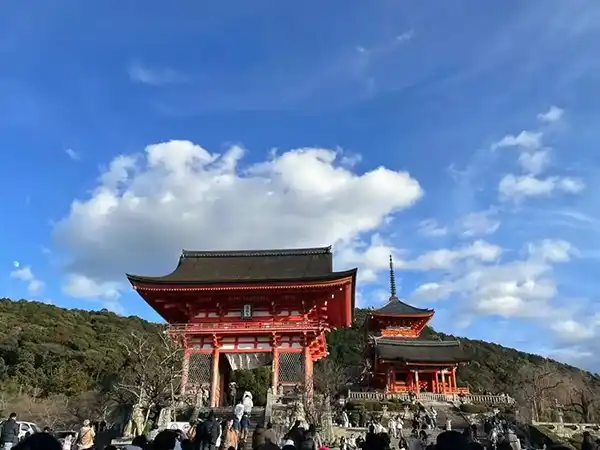Kyoto: Where Ancient Tradition Meets Modern Elegance
Nestled in a valley between forested mountains, Kyoto stands as Japan’s cultural heart—a city where time-honored rituals coexist with cutting-edge creativity. For over 1,000 years, it served as the imperial capital, shaping Japan’s art, spirituality, and identity. Today, its 2,000 temples and shrines whisper tales of samurai and geisha, while its avant-garde galleries and Michelin-starred kitchens redefine tradition. Whether you’re meditating in moss-covered Zen gardens, savoring tofu crafted by monks, or exploring neon-lit alleyways, Kyoto offers a journey through Japan’s soul.
A Living Museum of History and Culture
Kyoto’s essence lies in its preservation of Japan’s spiritual and artistic heritage. The Kinkaku-ji (Golden Pavilion), a Zen temple cloaked in gold leaf, reflects serenely over a mirror-like pond, embodying the Muromachi period’s aesthetic ideals. Nearby, Kiyomizu-dera, a wooden marvel built without nails, juts out from a hillside, offering panoramic views of cherry-blossom valleys—a UNESCO site that has drawn pilgrims since 778 CE.
The Gion district remains the epicenter of geisha culture. At dusk, lantern-lit teahouses come alive with the soft clatter of okobo (wooden sandals) as apprentice geiko (geisha) glide to secret performances. Visitors can glimpse this world through cultural workshops like Maiko Makeover Experiences or evening ozashiki dinners featuring traditional dance. For deeper historical immersion, the Nishijin Textile Center showcases Kyoto’s silk-weaving legacy, where artisans demonstrate how kimono brocades are woven for tea ceremonies and royal weddings.
Kyoto’s spiritual duality shines at Fushimi Inari Taisha, a Shinto shrine famed for its 10,000 vermilion torii gates snaking up Mount Inari. By contrast, the Ryoan-ji Rock Garden distills Zen philosophy into 15 stones arranged in raked gravel—an invitation to contemplate simplicity.
Modern Art: Bridging Past and Future
While steeped in tradition, Kyoto pulses with contemporary artistry. The Kyoto International Manga Museum celebrates Japan’s graphic storytelling legacy, housing 300,000 works from Edo-era woodblock prints to Sailor Moon. For experimental installations, the DOX Centre for Contemporary Art repurposes a factory into a space where political themes collide with multimedia.
Traditional crafts also evolve here. In the Arashiyama Bamboo Grove, artists like Tatsuya Matsui reinterpret bamboo into luminous sculptures at HOSOO Gallery, a 350-year-old textile studio turned avant-garde exhibit space. Meanwhile, Kiyomizu Sannenzaka street blends old and new: centuries-old pottery shops sit beside % Arabica, a minimalist coffee roastery where baristas craft matcha lattes under exposed beams.
Nature’s Masterpiece: Gardens and Wilderness
Kyoto’s landscapes are living art. The Philosopher’s Path, a cherry tree-lined canal, blooms pink in spring and fiery red in autumn—a favorite stroll for poets and thinkers. The Imperial Palace’s Sento Garden epitomizes shakkei (borrowed scenery), framing distant mountains within its manicured ponds.
Venture beyond the city to Arashiyama, where the Sagano Bamboo Forest sways in hypnotic unison, its stalks creaking like a natural symphony. Nearby, the Hozu River carves through cliffs, best explored by vintage train rides or rafting tours. For solitude, Ohara Village, a 40-minute bus ride north, offers terraced rice fields and the Sanzen-in Temple, where mossy statues peer from maple-shaded gardens.
Culinary Poetry: From Temple Cuisine to Street Bites
Kyoto’s food culture mirrors its refinement. Kaiseki, the pinnacle of Japanese haute cuisine, is perfected at Kikunoi, where seasonal dishes like cherry-blossom shrimp and yuzu-marinated sea bream are served on antique lacquerware. For vegetarian fare, Shigetsu inside Tenryu-ji Temple offers shojin ryori (Buddhist vegan meals), featuring sesame tofu and mountain vegetable tempura.
Street food thrives at Nishiki Market, a 400-year-old arcade dubbed “Kyoto’s Kitchen.” Sample tako tamago (candied octopus), matcha soft-serve, and Nakamura Tokichi’s gold-leaf-adorned wagashi (sweets). Ramen lovers queue at Menya Ippudo for silky pork-broth noodles, while Kichi Kichi Omurice entertains with its theatrical, wobbly egg omelets.
Don’t miss Kyoto’s sake heritage. The Fushimi District, home to 40 breweries, offers tastings at Gekkeikan Okura Sake Museum, where cedar-aged brews pair with local pickles.
Shopping: From Silk Scrolls to Streetwear
Kyoto’s shopping scene balances heritage and hipsterism. Kyūkyodō, founded in 1663, sells hand-painted incense and washi paper, while Ippodo Tea offers ceremonial-grade matcha in elegant tins. For contemporary finds, D&Department Kyoto curates minimalist goods made by local artisans, from indigo-dyed aprons to bamboo cutlery.
The Teramachi and Shinkyogoku arcades buzz with youth culture. Browse vintage kimonos at Chicago Thrift Store, manga at Mandarake, or Studio Ghibli merch at Donguri Kyowakoku. Luxury seekers flock to Takashimaya Department Store for Kyoto-exclusive skincare like Yojiya blotting papers—a geisha secret for matte complexion.
Practical Magic: Navigating Kyoto
• Timing: Visit in April for cherry blossoms or November for autumn foliage. Summer (June–August) is humid but ideal for Gion Matsuri festivals.
• Transport: Rent a bicycle (¥1,000/day) to explore temples; use the JR Pass for day trips to Nara or Osaka.

• Etiquette: Remove shoes at temples, avoid loud voices in gardens, and never photograph geisha without consent.
Kyoto is more than a destination—it’s a sensory pilgrimage. Wander its cobblestone alleys at dawn, when mist clings to pagodas, or join locals releasing paper lanterns on the Kamo River during Obon. As the saying goes, “Kyoto is Japan, and Japan is Kyoto.” Let its beauty unfold slowly, one tea ceremony, one sunset, one unforgettable flavor at a time.